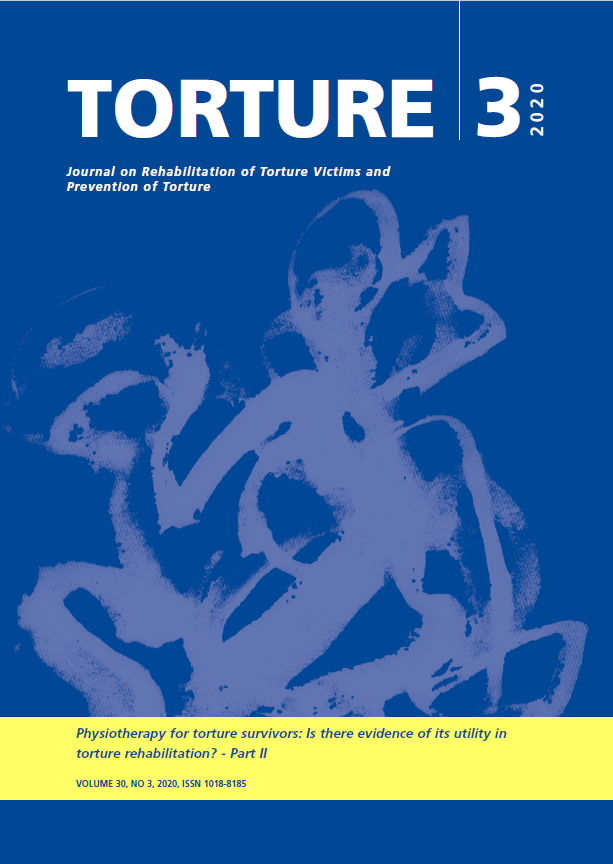International survey of the utilisation of physiotherapy in treatment centers for survivors of torture
DOI:
https://doi.org/10.7146/torture.v30i3.122775Keywords:
Physiotherapy, international survey, modalities, barriers, collaborationAbstract
Introduction: Literature about treatment of survivors of torture tends to focus on counseling and primary medical care. There are fewer published articles about the utilization of physiotherapy at treatment centers for survivors of torture and other forms of trauma.
Methods: Lists were compiled of about 169 treatment centers receiving funding from the United National Voluntary Fund, 150 from the International Rehabilitation Council for Torture Victims, and another 40 treatment centers in the United States through the National Capacity Building Project. A survey about utilization of physiotherapy at treatment centers for survivors was created which included questions about the utilization of physiotherapy, treatment modalities provided by physiotherapists, other professionals working at the centers, perceived barriers to providing physiotherapy and interest in collaboration as a global physiotherapy community. Surveys were emailed to centers in French, Spanish and/or English.
Results: 87 responses were received, for a response rate of 43% (87 of 200 emails sent). Approximately 30% of centers report that their clients have no access to physiotherapy, with one third of the centers having physiotherapy on staff (in contrast with 85% of survey respondents having psychotherapy/counseling on staff, 73% having social work on staff and 55% primary medicine). About one third of responding torture treatment programs reported being able to refer to physiotherapists outside of their centers. Therapeutic exercise, manual therapy, massage, and group activities and exercises were the most commonly reported treatment modalities provided by physiotherapists. Lack of funds or resources and shortage of physiotherapy personnel were perceived as being the biggest challenges limiting clients’ access to physiotherapy. Twenty-nine of the respondents (33%) were physiotherapists, and of these, 90% reported being interested in collaborative activities with other physiotherapists working with survivor of torture.
References
Amris, K., Jones, L., & Williams, A. (2019). Pain from torture: Assessment and management. Pain Reports, 4(6), e 794. https://doi.org/10.1097/PR9.0000000000000794
Baird, E., de Williams, C., Hearn, A., & Amris, K. (2017) Interventions for treating persistent pain in survivors of torture. Cochrane Database Systems Review. https://doi.org/10.1002/14651858.CD012051
Bunn, M., Goesel, C., Kinet, M., & Ray, F. (2016). Group treatment for survivors of torture and severe violence: A literature review. Torture, 26(1), 45-67. https://doi.org/10.7146/torture.v26i1.108062
Gamble, A, Ahmed, A. M. A., Rahim, S. H., & Hartman, J. (2020). The effects of combined psychotherapy and physiotherapy group treatment program for survivors of torture incarcerated in an adult prison in Kurdistan, Iraq: A pilot study. Torture, 30(2), 58-76. https://doi.org/10.7146/torture.v30i2.119199
Gueron, L. P., Amoyi, A., Chao, W., Chepngetcih, J., Kibet, J. J., Nyambok, S., & Wesonga, J. (2020). Group physiotherapy with survivors in urban and camp settings in Jordan and Kenya. Torture, 30(2), this issue.
Harlacher, U., Polatin, P., Taing, S., Phana, P., Sok., P., & Sothera, C. (2019). Education as a treatment for chronic pain in survivors of trauma in Cambodia: Results of a randomized controlled outcome trial. International Journal of Conflict and Violence, 13, 1-26. https://doi:10.4119/UNI9/ijcv.655
Kira, I.A., Ahmed, A., Mahmoud, V., & Wassim, E. (2010). Group therapy model for refugee and torture survivors: Treatment model innovations. International Journal of Group Psychotherapy, 62(1). https://doi.org/10.1521/ijgp.2012.62.1.69
Nordbrandt, M. S., Sonne, C., Mortensen, E. L., & Carlsson, J. (2020). Trauma-affected refugees treated with basic body awareness therapy or mixed physical activity as augmentation to treatment as usual—A pragmatic randomized controlled trial. PLos One, 15(3), e0230300. https://doi.org/10.1371/journal.pone.0230300
Stammel, S., Knaevelsud, C., Schock, K., Walther, L.C. S., Wenk-Ansohm, M. P., & Bottche, M. (2017). Multidisciplinary treatment for traumatized refugees in a naturalistic setting: symptom courses and predictors. European Journal of Psychotraumatology. 8(2), https://doi.org/10.1080/20008198.2017.1377552
Wang, S., Bytyci, A., Izeti, S., Hallaba, M., Rushti, R., Montgomery, E., & Modvig, J. (2016). A novel bio-psycho-social approach for rehabilitation of traumatized victims of torture and war in the post-conflict context: A pilot randomized controlled trial in Kosovo. Conflict and Health, 10(34). https://doi.org/10.1186/s1303`-016-0100-y
Yuce, H., & Bahrilli, T. (2020). The impact of Basic Body Awareness Therapy on balance and quality of life in survivors of hunger strike with Wernicke Korsakoff syndrome. Torture, 30(2), 77-88. https://doi.org/10.7146/torture.v30i2.120163
Downloads
Published
How to Cite
Issue
Section
License
We accept that some authors (e.g. government employees in some countries) are unable to transfer copyright. The Creative Commons Licence Attribution-NonCommercial-NoDerivatives 4.0 International (CC BY-NC-ND 4.0) covers both the Torture Journal and the IRCT web site. The publisher will not put any limitation on the personal freedom of the author to use material contained in the paper in other works which may be published, provided that acknowledgement is made to the original place of publication.


